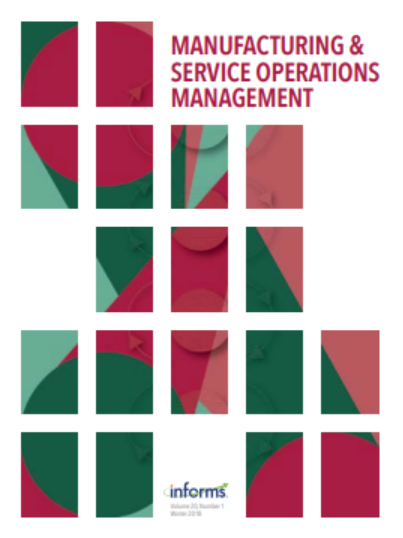Probabilistic Forecasting of Patient Waiting Times in an Emergency Department
IF 4.8
3区 管理学
Q1 MANAGEMENT
M&som-Manufacturing & Service Operations Management
Pub Date : 2023-07-01
DOI:10.1287/msom.2023.1210
引用次数: 0
Abstract
Problem definition: We study the estimation of the probability distribution of individual patient waiting times in an emergency department (ED). Whereas it is known that waiting-time estimates can help improve patients’ overall satisfaction and prevent abandonment, existing methods focus on point forecasts, thereby completely ignoring the underlying uncertainty. Communicating only a point forecast to patients can be uninformative and potentially misleading. Methodology/results: We use the machine learning approach of quantile regression forest to produce probabilistic forecasts. Using a large patient-level data set, we extract the following categories of predictor variables: (1) calendar effects, (2) demographics, (3) staff count, (4) ED workload resulting from patient volumes, and (5) the severity of the patient condition. Our feature-rich modeling allows for dynamic updating and refinement of waiting-time estimates as patient- and ED-specific information (e.g., patient condition, ED congestion levels) is revealed during the waiting process. The proposed approach generates more accurate probabilistic and point forecasts when compared with methods proposed in the literature for modeling waiting times and rolling average benchmarks typically used in practice. Managerial implications: By providing personalized probabilistic forecasts, our approach gives low-acuity patients and first responders a more comprehensive picture of the possible waiting trajectory and provides more reliable inputs to inform prescriptive modeling of ED operations. We demonstrate that publishing probabilistic waiting-time estimates can inform patients and ambulance staff in selecting an ED from a network of EDs, which can lead to a more uniform spread of patient load across the network. Aspects relating to communicating forecast uncertainty to patients and implementing this methodology in practice are also discussed. For emergency healthcare service providers, probabilistic waiting-time estimates could assist in ambulance routing, staff allocation, and managing patient flow, which could facilitate efficient operations and cost savings and aid in better patient care and outcomes. Supplemental Material: The online supplement is available at https://doi.org/10.1287/msom.2023.1210 .急诊病人等待时间的概率预测
问题定义:我们研究在急诊科(ED)的个体病人等待时间的概率分布估计。虽然已知等待时间估计可以帮助提高患者的整体满意度和防止放弃,但现有的方法侧重于点预测,从而完全忽略了潜在的不确定性。仅向患者传达一个点预测可能会缺乏信息,并可能产生误导。方法/结果:我们使用分位数回归森林的机器学习方法来产生概率预测。使用大型患者级别的数据集,我们提取了以下类别的预测变量:(1)日历效应,(2)人口统计,(3)员工数量,(4)患者数量导致的ED工作量,以及(5)患者病情的严重程度。我们的特征丰富的建模允许在等待过程中显示患者和ED特定信息(例如,患者状况,ED拥堵程度)时动态更新和改进等待时间估计。与文献中提出的模拟等待时间和实际使用的滚动平均基准的方法相比,所提出的方法产生了更准确的概率和点预测。管理意义:通过提供个性化的概率预测,我们的方法为低敏锐度患者和急救人员提供了更全面的可能等待轨迹,并为急诊科手术的规范性建模提供了更可靠的输入。我们证明,发布概率等待时间估计可以告知患者和救护人员从急诊室网络中选择急诊室,这可以导致患者负荷在整个网络中更均匀地分布。还讨论了与患者沟通预测不确定性和在实践中实施这种方法有关的方面。对于紧急医疗保健服务提供商,概率等待时间估计可以帮助确定救护车路线、人员分配和管理患者流量,从而促进高效操作和节省成本,并有助于改善患者护理和结果。补充材料:在线补充材料可在https://doi.org/10.1287/msom.2023.1210上获得。
本文章由计算机程序翻译,如有差异,请以英文原文为准。
求助全文
约1分钟内获得全文
求助全文
来源期刊

M&som-Manufacturing & Service Operations Management
管理科学-运筹学与管理科学
CiteScore
9.30
自引率
12.70%
发文量
184
审稿时长
12 months
期刊介绍:
M&SOM is the INFORMS journal for operations management. The purpose of the journal is to publish high-impact manuscripts that report relevant research on important problems in operations management (OM). The field of OM is the study of the innovative or traditional processes for the design, procurement, production, delivery, and recovery of goods and services. OM research entails the control, planning, design, and improvement of these processes. This research can be prescriptive, descriptive, or predictive; however, the intent of the research is ultimately to develop some form of enduring knowledge that can lead to more efficient or effective processes for the creation and delivery of goods and services.
M&SOM encourages a variety of methodological approaches to OM research; papers may be theoretical or empirical, analytical or computational, and may be based on a range of established research disciplines. M&SOM encourages contributions in OM across the full spectrum of decision making: strategic, tactical, and operational. Furthermore, the journal supports research that examines pertinent issues at the interfaces between OM and other functional areas.
 求助内容:
求助内容: 应助结果提醒方式:
应助结果提醒方式:


